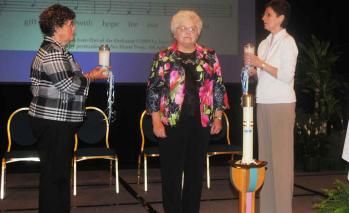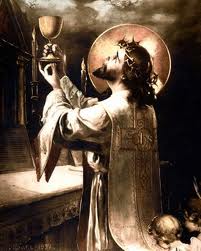Thursday bears a special significance for the Church. It was on a Thursday that Christ instituted the sacraments of the Holy Eucharist and the Priesthood. Traditionally, it was on a Thursday when Christ ascended to the heavens, mounting his throne amidst shouts of joy from the angels.
Up until the year 2000, Texas had celebrated the Solemnity of the Ascension on its traditional day, Thursday, exactly 40 days after Easter. Unfortunately, the bishops reached the decision to translate this very important day from its biblically traditional date to the closest Sunday. The usual suspect for this particular line of thinking was that it was for "pastoral" reasons. Sadly, sometimes even pastoral decisions are not always the best ones.
When we begin to tinker with sacred liturgical time, we lose sight of the deeper meaning behind why, for nearly two millennia, the Church celebrated this feast when she did (although certain places, praise God, still maintain the tradition). The number 40 holds a special designation for Ancient Israel and the New Israel, which is the Church. Noah and the occupants of the ark endured the Great Flood for 40 days. Ancient Israel wandered in the desert for 40 years. The Blessed Virgin Mary and St. Joseph presented the infant Jesus in the Temple 40 days after His birth. Jesus spent 40 days in the desert fasting and praying, vanquishing Satan and his temptations towards the end. As St. Luke tells us in the beginning of the Acts of the Apostles, for 40 days after his triumphant Resurrection, Christ instructed the surviving 11 Apostles, spending no little time with them to prepare them for the great work that lay ahead.
On the 40th day, Thursday, St. Luke tells us that Christ has been "at table" with the Apostles. In St. Luke's Gospel, this "table" connection appears another time: Emmaus. Jesus is at "table" with Cleopas and the other disciple when He breaks the bread, revealing who He is. Jesus has one more liturgy with His Apostles, telling them that they must now look to Him in the Eucharist. And, when did He first reveal Himself in the Eucharist? It happened on Holy Thursday. Again, we see the connection between Holy Thursday and Ascension Thursday.
Jesus reminds them to "do this in memory of Me", to celebrate the Holy Eucharist. He returns them to the place where it first took place. Then, he leads them to Mount Olivet, the site of His agony in the Garden. That sorrowful night was the last time that 10 of them probably saw Him before the soldiers took him away. Now, this would be the last time that the 11 would physically see Christ on this Earth. Jesus enjoins them to remain in Jerusalem until the Holy Spirit comes upon them. The same men who left Mount Olivet in fear the night Jesus was betrayed would burst forth from the Upper Room with courage and zeal, bearing witness to Christ "not only in Jerusalem, but throughout Judea and Samaria, and indeed, to the ends of the Earth."
Then, Christ blesses them for the last time and then, on His own power, He is lifted up while the Apostles look up and a cloud removes Him from sight. Two angels appear to the 11 and tell them that Jesus will come back in the same way just as they had seen him ascend. The Apostles then return to the Upper Room, joined by the Blessed Mother, and begin the first novena, engaging themselves in nine days of prayer. On the fiftieth day, the Holy Spirit descends upon them, bursting into the Upper Room and literally inflaming the hearts of the Apostles, while Mary, who was already full of the Holy Spirit, witnesses the launch of the Church.
Biblically, numerically and liturgically, Thursday needs to be preserved. The Church traces many of her practices to Ascension Thursday. We get our reckoning of the Proper of Time from Easter Sunday and count 40 days to Ascension Thursday. From Ascension Thursday, we trace our practice of the novena, nine days of Prayer, reminding ourselves that the Apostles spent these days in intense prayer with the Blessed Virgin Mary. On the fiftieth days of Easter, we mark the descent of the Holy Spirit. We get the name Pentecost (whose root comes from 50) because, 50 days after the celebration of the Passover, Ancient Israel celebrated the feast of Pentecost. That is why so many of Ancient Israel's children were in Jerusalem.
For nearly 2,000 years, the Church kept this sacred time intact. However, something happened that has caused us to lose track of this very important and sacred time. Up until the year 2000, it did not seem to me that it was too much of a hardship or an imposition for people to go to one extra Mass during the week. If parents can make time to take their children to extracurricular activities such as karate, baseball practice, band practice, cheerleading events or other things, or if adults can make time to slavishly attend their gym regimen (zumba, spinning, weights, etc), why not invest the same time for God? Why not celebrate the fact that Christ raised the dignity of our humanity by taking His body back to heaven?
Maybe the United States Conference of Catholic Bishops (and, by extension, the bishops of Texas), thought that an additional day out of the week for Mass was too much of a burden so they came up with some sort of "pastoral" reason to move this important feast to Sunday. I would submit to them that this is a short-sighted practice because it actually reduces the significance of what that day means. When we break the connection that Ascension Thursday has with Holy Thursday and with the commemoration of the first Novena, then we lose sight of the beauty of the biblical and ecclesiastical significance that this solemnity has. Furthermore, if we are not impacted by the fact that Christ did not despise His humanity but took it with Him back to the Father, then, moving the Ascension to Sunday really does not do much.
I do take comfort in the fact that Pope Emeritus Benedict XVI issued Summorum Pontificum, which liberalized the use of the Mass in the Extraordinary Form. At least in the 1962 Roman Missal, the integrity of Ascension Thursday is preserved. Lamentably, the closest celebration of the Mass in the Extraordinary Form is three hours away in the Rio Grande Valley. As much as I wanted to go to the Oratory in Pharr, I could not due to work. However, I do intend to take time off next year and go.
I do pray that the bishops of Texas will come to the realization that restoring Ascension Thursday to its proper celebration takes us back to our scriptural and liturgical roots. The law of prayer is the law of belief; however, if we arbitrarily move feasts for the sake of convenience, then we have lost the connection to what is sacred and we risk having future generations that do not understand the significance of why the Church does what she does.







